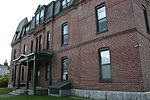Hanover Insurance Park at Fitton Field

Hanover Insurance Park at Fitton Field is a baseball stadium in Worcester, Massachusetts. Primarily used for College of the Holy Cross sporting events, the baseball stadium also served as the home field for the Can-Am League Worcester Tornadoes, and the current home of the Futures Collegiate Baseball League Worcester Bravehearts. The stadium is named after the Reverend James Fitton, who donated land to the Archdiocese of Boston to found the college.The baseball stadium lacks any outfield bleachers due to the proximity of Interstate 290 and the Fitton Field football stadium. Fitton Field hosted the MIAA High School Baseball State Finals in 2012 and has hosted them each year since 2014. During football season, the baseball field is used for parking and tailgating.
Excerpt from the Wikipedia article Hanover Insurance Park at Fitton Field (License: CC BY-SA 3.0, Authors, Images).Hanover Insurance Park at Fitton Field
I 290, Worcester
Geographical coordinates (GPS) Address Nearby Places Show on map
Geographical coordinates (GPS)
| Latitude | Longitude |
|---|---|
| N 42.240527777778 ° | E -71.811222222222 ° |
Address
Filton Baseball Field (Hanover Insurance Park)
I 290
01610 Worcester
Massachusetts, United States
Open on Google Maps









